The GIGABYTE Z390 Aorus Pro WIFI Motherboard Review: A Sturdy $200 Surprise
by Gavin Bonshor on April 12, 2019 10:00 AM ESTVisual Inspection
The GIGABYTE Z390 Aorus Pro WIFI positions itself in a highly contested price bracket at $200 and looks to stand out as one of the most unique styled ATX sized Z390 motherboards. It has stiff competition from models such as the ASRock Z390 Phantom Gaming 6 ($196), the ASUS ROG Strix Z390-H Gaming ($190) and the MSI MPG Z390 Gaming Pro Carbon ($200).
Nestled onto a fully black PCB is a nicely contrasting Aorus Falcon logo coming from the bottom left and the GIGABYTE Z390 Aorus Pro WIFI uses a black and silver heatsinks with a black glossy plastic rear panel cover. An Aorus Falcon is subtly carved into the chipset heatsink which doubles up as one of the customizable RGB LED zones along with others in the audio PCB separation line, the Aorus logo in the rear panel cover and in-between the RAM slots. Users looking to expand upon this can do so via the two 5050 RGB and two addressable RGB headers. For the price, the GIGABYTE Z390 Aorus Pro WIFI offers eight 4-pin headers which cement it as one of the most comprehensive Z390 boards for cooling, let alone for the price. These are divided into four different areas which include one for a CPU fan, two water cooling pumps, a water cooling fan and four system fans.
On the memory front, the GIGABYTE Z390 Aorus Pro WIFI has support for both ECC and non-ECC unbuffered memory with a maximum supported capacity of up to 128 GB across four available slots; this is due to official support for the new 32 GB UDIMM DDR4 modules. For users looking to use high-spec DDR4 memory, the Z390 Aorus Pro WIFI also supports up to DDR4-4266 memory in dual-channel with XMP 2.0 profiles.
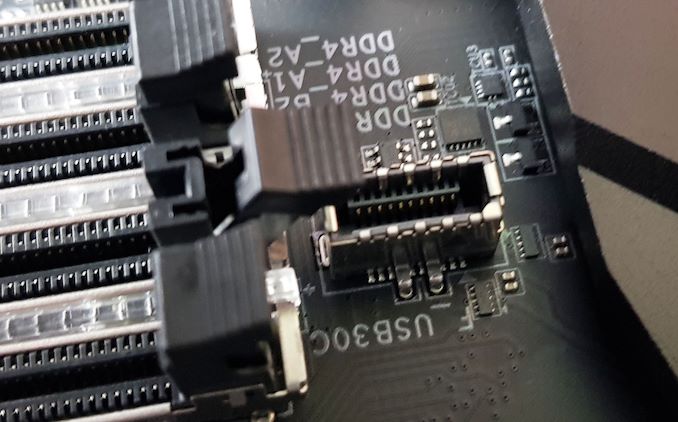
The front panel USB Type-C header is too close to the RAM slot clasp
Just like we found in our GIGABYTE Z390 Aorus Master review, the front panel USB 3.1 G1 Type-C header sits very close to one of the RAM slot clasps and could potentially make installing and uninstalling memory an issue if the header is in use. The quick fix would be to unplug the header temporarily while installing the memory, but if everything required a quick fix, then it wouldn't exactly be convenient and as a result, it's a negative that needed to be mentioned. For reference, the GIGABYTE Z390 Aorus Master which costs $290 has seven.
Located on the southern area of the board are three full-length PCIe 3.0 slots with the first and second slot getting a treatment of metal slot protection. These slots are run from the CPU and support x16 or x8/x8, while the third slot remains bare and is limited to just x4 from the chipset. This means that two-way SLI and up to three-way CrossFire multi-graphics card configurations can be used. In addition to the full-length slots, there are three PCIe 3.0 x1 slots present. Sandwiched in between the boards PCIe slots are two M.2 slots which each slot featuring its own M.2 heatsink. The top M.2 slot supports M.2 22110 drives whereas the bottom M.2 slot has support for up to M.2 2280. There is also a total of six SATA ports which allow for RAID 0, 1, 5 and 10 arrays to be used.
| GIGABYTE Z390 Aorus Pro WIFI PCIe Layout | |||
| Number of Installed PCIe Cards on CPU |
PCIe_1 | PCIe_2 | PCIe_3 |
| x1 | x16 | - | - |
| x2 | x8 | x8 | - |
| x3 | x8 | x8 | x4 |
Underneath the rather hefty L shaped heatsink, which is fused together with a heat pipe, is a large power plane with a 12+1 phase power delivery. The power delivery is regulated by an Intersil ISL69138 7-channel PWM controller with a total of twelve Vishay SiC634 50 A power stages which are doubled by six Intersil ISL6617 doublers. A single Vishay SiC632 50 A power stage is used for the iGPU which technically speaking means the GIGABYTE Z390 Aorus Pro WIFI is running in a 6+1 configuration. Each of the 50 A power stages gets its own indeterminable inductor which means the CPU V-Core and iGPU sections feature thirteen in total. Providing power to the power delivery is a single 8-pin and 4-pin 12 V connector.
| Z390 Motherboard Power Delivery Comparison | |||||
| Motherboard | Controller | H-Side | L-Side | Chokes | Doubler |
| ASUS ROG Strix Z390-I Gaming | ASP1401CTB (4+2) |
ON NCP302045 (6) |
11 | - | |
| ASRock Z390 Taichi | IR35201 (5+2) |
TI 87350D (12) ON FDPC5939SG (2) |
14 | IR3598 (6) |
|
| ASRock Z390 Taichi Ultimate | IR35201 (5+2) |
TI 87350D (12) ON FDPC5939SG (2) |
14 | IR3598 (6) |
|
| ASRock Z390 Phantom Gaming 9 | IR35201 (5+2) |
TI 87350D (12) ON FDPC5939SG (2) |
14 | IR3598 (6) |
|
| GIGABYTE Z390 Aorus Master | IR35201 (6+2) |
IR3553 (12) |
14 | IR3599 (6) |
|
| GIGABYTE Z390 Aorus Ultra | ISL69138 (6+1) |
SiC634 (12) |
13 | ISL6617A (6) |
|
| GIGABYTE Z390 Aorus Pro WiFi | ISL69138 (6+1) |
SiC634 (12) |
13 | ISL6617A (6) |
|
| GIGABYTE Z390 Aorus Pro | ISL69138 (6+1) |
SiC634 (12) |
13 | ISL6617A (6) |
|
| GIGABYTE Z390 Aorus Elite | ISL69138 (6+1) |
SiC634 (12) |
13 | ISL6617A (6) |
|
| GIGABYTE Z390 I Aorus Pro WiFi | IR35201 (6+2) |
IR3553 (6) |
8 | - | |
| GIGABYTE Z390 Gaming SLI | ISL69138 (5+2) |
PPak (10) |
12 | ISL6617A (5) |
|
| GIGABYTE Z390 Gaming X | ISL69138 (5+2) |
PPak (10) |
12 | ISL6617A (5) |
|
| GIGABYTE Z390 UD | ISL69138 (5+2) |
PPak (10) |
12 | ISL6617A (5) |
|
| MSI MEG Z390 ACE | IR35201 (6+2) |
ON4C029N (12) |
ON4C024N (12) |
13 | IR3598 (6) |
| Supermicro C9Z390-PGW | PXE1610 (6+1) PXM1310 (3+1) |
TDA21232 (6) TDA21240 (2) |
8 | - | |
The boards audio PCB is quite simple and straight forward with an illuminated PCB separation line with the primary focus around the EMI shielded Realtek ALC1220-VB HD audio codec. Complementing this is a total of eleven audio capacitors; seven gold and four WIMA capacitors. Situated next to these are a single front panel audio and S/PDIF header.
The bulk of rear panel connections are made of USB ports There are two USB 3.1 G2 Type-A, one USB 3.1 G2 Type-C, three USB 3.1 G1 Type-A and four USB 2.0 ports. Users have the option to use the included front panel headers with a single USB 3.1 G1 header (two ports), two USB 2.0 headers (four ports) and a single USB 3.1 G2 Type-C header (one port). The Z390 Aorus Pro WIFI benefits from an Intel 9560 2T2R Wave 2 802.11ac Wi-Fi adapter which uses the Z390's CNVi for speeds up to 1.73 Gbps. A single Ethernet port is powered by an Intel I219V 1 GbE NIC, which the five 3.5 mm audio jacks and S/PDIF optical output take direction from the Realtek ALC1220-VB HD audio codec. A single HDMI 1.4 video output is present for users looking to use onboard graphics. More of a design aspect than one of function, the rear panel comes supplied with a pre-attached IO shield.
What’s in the Box
Bundled with the GIGABYTE Z390 Aorus Pro WIFI is plenty for users to sink their teeth into with four RGB LED extensions (one for each header), two M.2 mounting kits, four SATA cables and the usual driver installation disk, and installation manual. A dual band antenna for the Intel 9560 802.11ac also sits within the included accessories bundle. This feels like a good package for the capabilities of the board.
- Four SATA cables (two right-angled, two straight angled)
- Four RGB LED extension cables (two 5050, two addressable)
- Intel 9560 802.11ac Wi-Fi Antenna
- Two M.2 mounting kits with screws
- Instruction manual
- Driver/Utility installation disk
- Quick install guide
- Aorus case badge
- G connector


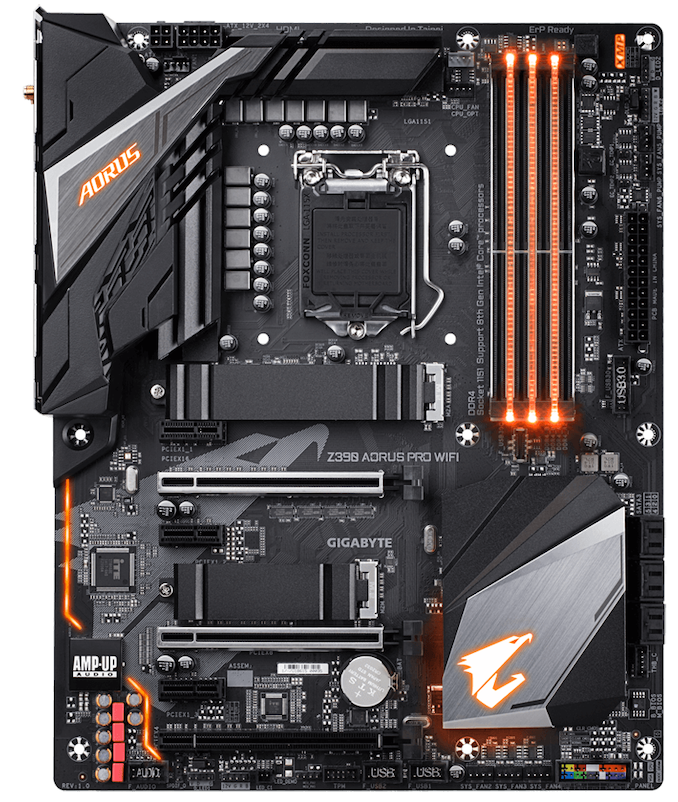
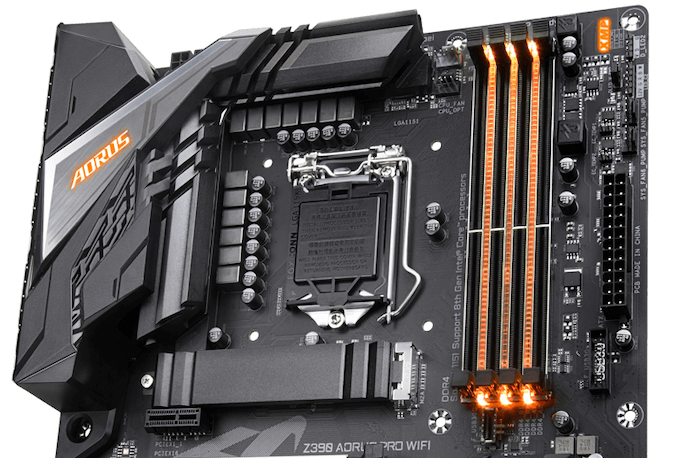
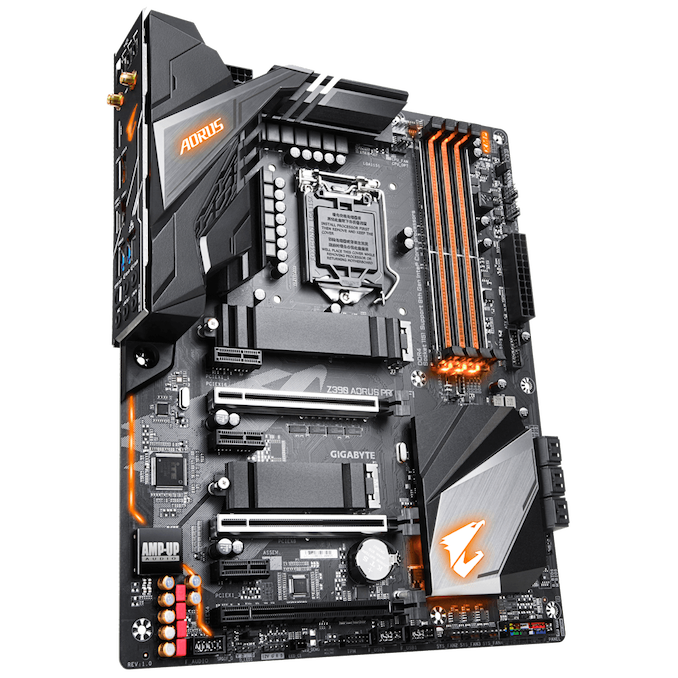
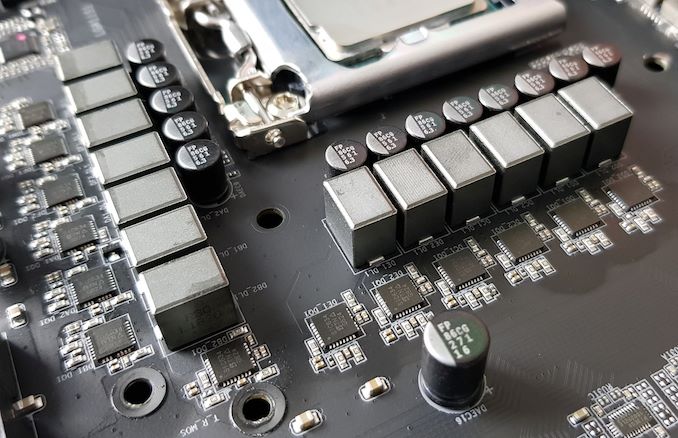
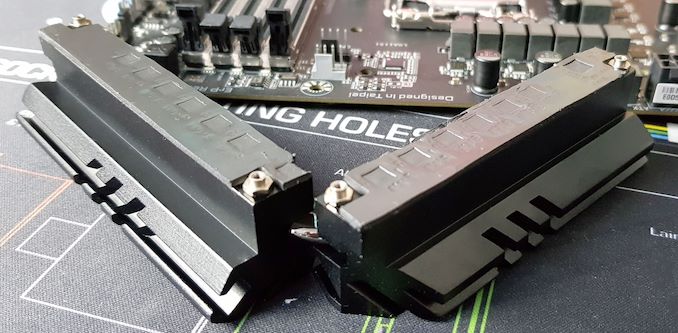
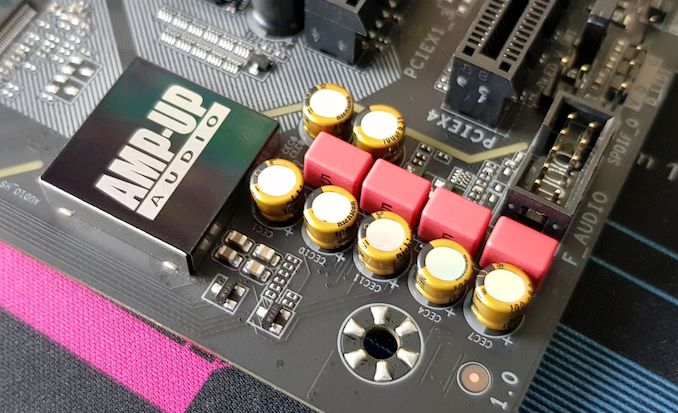

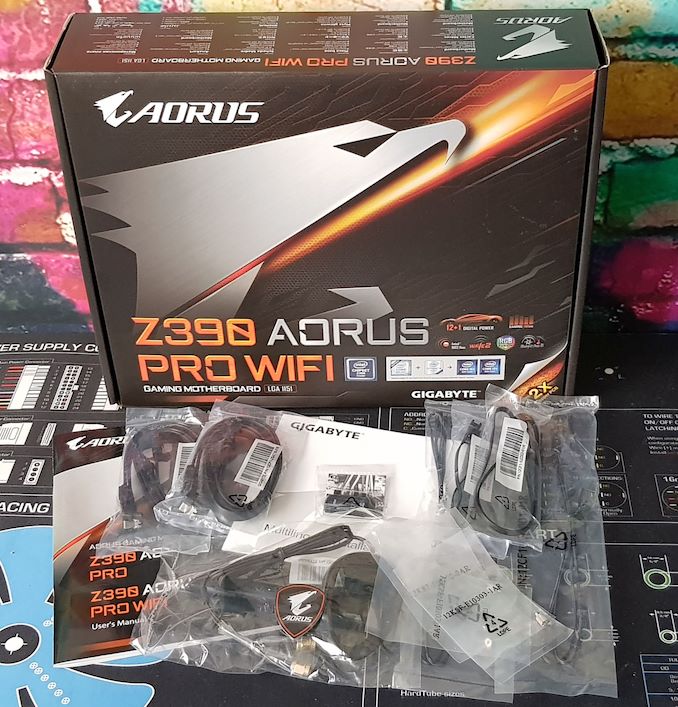








33 Comments
View All Comments
austinsguitar - Friday, April 12, 2019 - link
not with gigabytes current bios implementation.imaheadcase - Friday, April 12, 2019 - link
What a wonderful insight into something only you know.austinsguitar - Saturday, April 13, 2019 - link
i dont want to brag (because i really dislike gigabyte recently) but i have owned almost all chipsets from intel going back to p45 exclusively on gigabyte boards. i used them for a solid 10 years, religiously. they were my only board to go to, until i got tricked and humiliated buy the am4 boards they came out with on the mid end. never again man. im on an msi board and there is no going back. the bios is just buggy on all gigabyte boards. its not the best. they need to change things man.GlossGhost - Sunday, April 14, 2019 - link
Got an H81 Gigabyte board, and, I understand it's cheap but that bios is not only ugly but utterly buggy as well, surely they could have done better especially seeing what Asus can do for the same price.LoneWolf15 - Friday, May 17, 2019 - link
I'm going to be straight up....I've been building since the 80386. My first computer job was for a builder for three and a half years...I'm now 24 years into an IT career.
The BIOS could be better on this board in that it's somewhat disorganized, and not as intuitive as it could be. However, the features all work properly (currently at the F9 revision) and the board itself is rock-solid hardware.
This board, hands down, has the best VRM and feature implementation of boards in the mid-price range. ASUS delivers a better BIOS, but when you consider you can get this board for $180USD, I find the ROG Z390-H, Z390-F don't have as good of VRM setup, and the Z390-E doesn't either and costs far more. The MSI Z390 Gaming Edge AC has almost as good VRMs, but its featureset and polish is not quite as nice.
Considering the combination of features, price, and stability, the Z390 Aorus Pro WiFi is a mid-price bargain. I'm running an i9-9900K at constant 4.7GHz turbo on all eight cores without any effort on my part, at 100% load for days on end (Folding@Home) with two GTX 1070s in WiFi and it hasn't complained once.
psedog - Thursday, July 18, 2019 - link
I'm running this board with a 8700k (Delidded) at 5.3Ghz all core with a AVX offset of 2. It passes every stress test I've thrown at it and the intel XTU has me in the top 3% of 8700k's. Not bad for a $200 board.See the results for yourself. Look up my username in hwbot. (Adding the like flags this post as spam.)
Native7i - Sunday, April 14, 2019 - link
I’ve used z97x gigabyte board for 5 years straight not knowing RAM running at single channel all the time. Tried to fix it every possible way but never got it right. Last bios update was stuck on beta bios so, no help from gigabyte either. Right now I need new pc but also very sketchy about gigabyte boards.DanNeely - Tuesday, April 16, 2019 - link
If your ram is running single channel you plugged the second dimm into the wrong slot. 2 of the 4 slots are wired to channel A, the other two to channel B. Nothing in software can change which slots go where.LoneWolf15 - Saturday, May 25, 2019 - link
I'm going to say the same thing DanNeely said... if you did that, it is very likely you didn't have the DIMMS plugged into the correct sockets. Before this board, I had Gigabyte's Z97X-UD5H-Black. I ran it in 16GB (2 x 8GB) and 32GB (4 x 8GB) configurations and never had this problem. I ran the board for five years, with an i7-4790K running all cores at max turbo of 4.4GHz, with no hiccups whatsoever, solid as a rock.I like ASUS' BIOS, but not their misleading VRMS, nor their quality control (multiple reported issues there). I don't think MSI is bad at this range, but the similar Z390 Pro Carbon AC is $20-25 more. I've had this board for three weeks, two of them running an i9-9900K at 100% load on max eight-core turbo of 4.7GHz with two GTX 1070 cards also running on high load (Folding@Home) 24/7 and it has been rock solid. About the only things I wish I had were the debug LED (used rarely) and the power/reset buttons on the backplate (not found without paying above $250 for a board, not worth it); those are nice, but not necessary. I wouldn't hesitate to buy this board again
Foeketijn - Monday, April 15, 2019 - link
Unfortunately the people considering the Bios on a mobo are really a niche. I just put together two AM4 builds. Gigabyte gave some troubles untill I found the right bios. Asus also gave me troubles. 4 creative ways to update the bios. None worked. In the end asus told me to replace the thing because apperantly the current version was known not to work propperly.I'm on a time schedule. Who has time for that. I just hope the customer never resets it's bios.